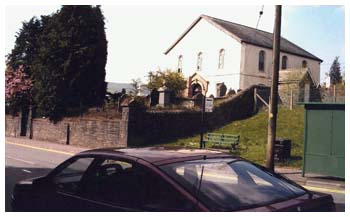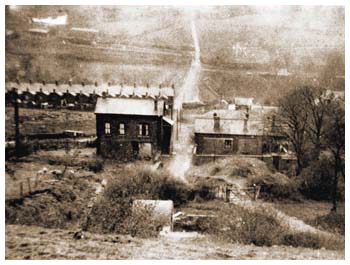
| Tonyrefail | |
| Tonyrefail village came into existence during the second half of the eighteenth century. Thomas Morgan, an old inhabitant of the village, supports this claim when he wrote and published his memories in a book entitled Hanes Tonyrefail in 1899. | |
He recounted conversations with many who recalled Tonyrefail village being one house. The village began to develop as a result of the enterprise of Evan Pritchard. He lived in Collena House situated on the brow of the hill overlooking the village where built a woollen factory and a corn mill. To drive these ventures' machinery, he constructed an extensive system of waterpower consisting of a weir across the River Ely, a 400 yard leat, a culvert and three ponds. Right: Collena House |
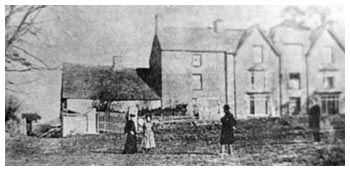 |
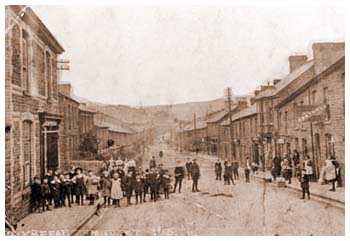 |
His death in 1795 saw Tonyrefail's growth slow markedly and the first decades of the nineteenth century witnessed little development. The one exception was the establishment of a shoemaker's workshop. According to the 1841 census thirteen shoemakers or cordwainers lived at Tonyrefail and it was by far the village's largest employer. Left: Mill Street circa 1900 |
Seven colliers and other tradesmen and craftsmen were also shown to inhabit it. Twenty years later however, the 1861 census showed that the number of colliers had more than doubled as limited exploitation of the coal near the surface through bell pits and shallow levels increased. The village's population showed a similar pattern as the number of inhabitants rose from 85 in 1841 to 160 in 1861. Right: The Blacksmiths - Tonyrefail |
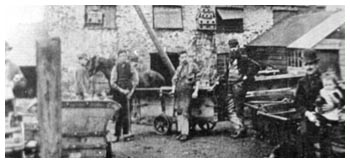 |
| The beginning of the 1860s marked an increase in the rate of Tonyrefail's growth. The catalyst for this expansion was the construction of a broad gauge railway line from Llantrisant through the Ely Valley to Tonyrefail and Penygraig. Built by the Ely Valley Railway Company, the line reached Tonyrefail in 1860 and was extended to Penygraig two years later. The Railway Company was also responsible for building the houses of Station Row. The 1871 census showed that they housed some ten railway employees and their families. | |
Capel y Ton |
By this time houses had also been built on both sides of Chapel Street and three short terraces were built at right angles to Collena Road in 1862. The 1871 census also showed that the village's population, including the Redgate area, had increased to over 300. Tonyrefail's commercial centre had developed and religious and educational buildings had emerged to meet the needs of the growing population. The Post Office opened in 1870 on Chapel Street later to be known as High Street. Capel y Ton Methodist Chapel, Tonyrefail's earliest chapel and first built in 1791, was rebuilt in 1863, whilst the previous year had seen the opening of the Ainon Baptist Chapel. The building of a new vestry at Capel Y Ton in 1857 marked the establishment of a new British School. A purpose built British School was opened in 1868. |
| The pace of Tonyrefail's growth and development accelerated quickly from the mid 1870s onwards as deep mines were sunk close to the village. Ty Du Colliery, Collena Colliery, Cil Ely Colliery, Ely Merthyr Colliery and Glyn Colliery were all located within a mile and a half of the village centre according to the 25 inches to 1 mile first edition ordnance survey map surveyed in 1874. Houses sprang up around Tonyrefail to accommodate the miners of these collieries and their families. The village's expansion was most rapid along Chapel Street and by 1891 the previously separate community of Redgate had joined up with Tonyrefail. Over 300 people now lived in the street, sixty of them were working in collieries. | 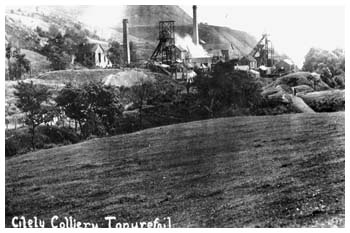 |
| Ten years later, the 1901 census showed that Tonyrefail's population had increased to over 2,200 and that the number employed in the coalmines was around 500. Despite some of the village's deep mines closing during the first decade of the twentieth century, the number of miners continued to grow as a result of the expansion of Coed-Ely Colliery sunk in 1901. The colliery was located some two miles to the south of the village and by 1919 employed a total of 1700 miners making the complex by far the biggest colliery of the area. The colliery was also equipped with both coke ovens and a complete by-product plant. Naturally Tonyrefail village continued to expand during the first decade as Pretoria Road, The Avenue and Prichard Street were built. The first decade also witnessed a period of modernisation and commercial expansion. Kelly's Trade Directory 1906 lists both the Tonyrefail & Gilfach Goch Electric Light Co. Lim., the company responsible for laying electric mains, and Richard Lewis, manager of the Lloyd Bank Branch. An exciting leisure attraction that opened above the Square in 1914 and shown on the 25 inches to 1 mile third edition Ordnance Survey map surveyed in same year was the Picture Theatre. |
|
Tylcha Fach level winding house Nantmelin 1928 |
The post First World War years saw council housing spring up in the area for the first time. The largest of these developments was built to the west of the Ely Valley line at Tynybryn between 1919-1922. However it wasn't until after the Second World War that any further development occurred. Council housing estates at the northern end of Tonyrefail were built in the 60s and 70s and private housing behind Penygareg and Heol Isaf were built in the 70s and 80s. Today the number of houses continues to rise despite the closure of Coed Ely Colliery in 1985. Developers are attracted to the village following recently completed road links. The track of the railway line became the route of the new road bypass from Coed Ely to Clydach allowing Tonyrefail's residents to commute to Cardiff and beyond
|
